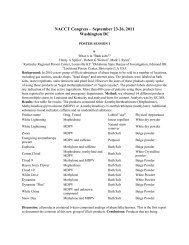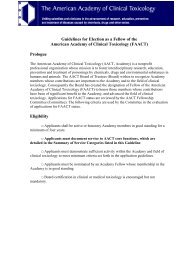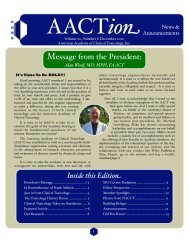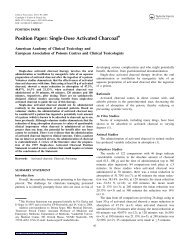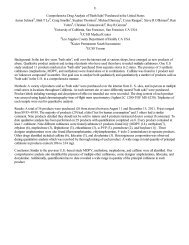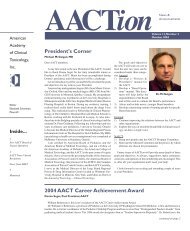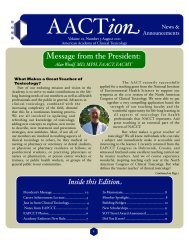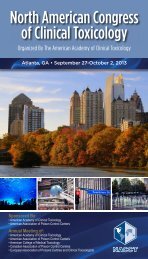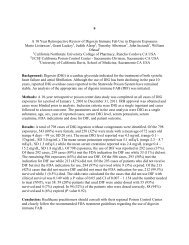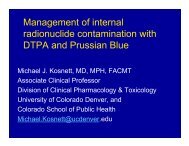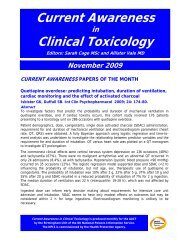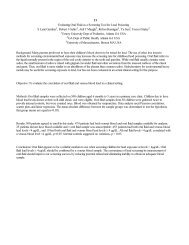Posters IV - The American Academy of Clinical Toxicology
Posters IV - The American Academy of Clinical Toxicology
Posters IV - The American Academy of Clinical Toxicology
You also want an ePaper? Increase the reach of your titles
YUMPU automatically turns print PDFs into web optimized ePapers that Google loves.
y phone for follow-up. Average monthly call volume at the GhPCC increased significantly from three to<br />
eight and a half calls per month in the six months pre- and post-implementation (two-tailed p=0.016).<br />
Percent calls from outside the Ridge Hospital also increased from 27% to 62%, but this change was not<br />
statistically significant (two-tailed p=0.093). Conclusions: Nurses who gave the health talks effectively<br />
reached large numbers <strong>of</strong> mothers. Overall call volume to the GhPCC increased significantly in the six<br />
months after program implementation. A trend toward increased utilization <strong>of</strong> the GhPCC hotline by<br />
community members and healthcare providers working outside the Ridge Hospital was also noted. More<br />
work is needed to raise public awareness <strong>of</strong> GhPCC services in Ghana, and to understand the barriers to<br />
PC utilization in the region.<br />
278<br />
Comparison <strong>of</strong> Educational Outcomes in Residents Receiving Internet Acetaminophen Curriculum vs.<br />
Live Lecture<br />
Andrew Stolbach 1<br />
1 Johns Hopkins University, Baltimore MD USA<br />
Background: A great number <strong>of</strong> poisoned patients are treated by emergency physicians without<br />
subspecialty training in toxicology. Medical <strong>Toxicology</strong> is co-sponsored as a subspecialty by the<br />
<strong>American</strong> Board <strong>of</strong> Emergency Medicine. Many toxicologists gain interest in their subspecialty<br />
during EM residency training. Despite the relationship between EM and medical toxicology,<br />
many EM residencies do not have a toxicologist on faculty or a dedicated toxicology rotation.<br />
Our objective was to compare educational outcomes in residents attending a live lecture on<br />
acetaminophen poisoning with those completing an internet learning module. Methods: We<br />
developed an internet-based acetaminophen education module. <strong>The</strong> module was formatted as a<br />
series <strong>of</strong> clinical vignettes. <strong>The</strong> module concludes with a posttest which was formatted in 4-<br />
choice best answer format. Items were written with the assistance <strong>of</strong> a specialist in education<br />
assessment and reviewed by outside toxicologists. <strong>The</strong> same posttest was administered to three<br />
separate groups: 1) "No training"- 33 residents and medical students who had no instruction<br />
2)"Live lecture"- 26 residents who had a live lecture delivered by a senior non-toxicology faculty<br />
3) "Internet module"- 9 residents who took the internet curriculum. <strong>The</strong> first two groups were a<br />
convenience sample <strong>of</strong> EM residents. <strong>The</strong> third group consisted <strong>of</strong> EM residents. <strong>The</strong> "live<br />
lecture" and "internet module groups completed the posttest immediately after the didactics.<br />
Three months after completing the module, the "internet module" group curriculum took a second<br />
follow-up test with items testing same objectives as the initial posttest. Outcomes measured were<br />
posttest scores (all groups) and 3-month posttest scores ("Internet module" group only.) Results<br />
were compared using two-tailed t-test. Results: <strong>The</strong> mean score for the "no training" group was<br />
46% (95% CI: 38%-54%.)<strong>The</strong> mean posttest score for the "live lecture" group was 51% (95% CI:<br />
42%-60%) <strong>The</strong> mean posttest score for the "internet module" group was 77% (95% CI: 65%-<br />
91%) and the mean 3-month follow-up score for the "internet module" group was 83% (95% CI:<br />
71%-95%.) In the internet learning group the mean posttest score and 3-month follow-up score<br />
were significantly higher (p



